2020 has been a very trying year. The current global pandemic just dropped on us unexpectedly, causing a lot of anxieties including food and supply shortages in many households everywhere. At one point, many had been fighting over what little inventories some grocery stores and markets had.
But these circumstances have still managed to bring out the best in a lot of people, preppers or not. We see many who were up to the challenge of acquiring new skills and learning to adjust to fruitfully cope with the difficulties of the times.
This season is a good reminder for you to learn how to make your own food and provisions out of the everyday items that you already have at home. One greatly essential food that you can start practicing with or begin learning to make is no-knead sourdough bread. Not only is it easy to make, but it also requires just a few ingredients.
Sourdough bread is a very practical method of bread baking for preppers. You can make a delicious loaf of no-knead sourdough bread using just water, flour, and salt. Sourdough bread also has a longer shelf life than the typical bread you can buy in-store.
Making The Bread
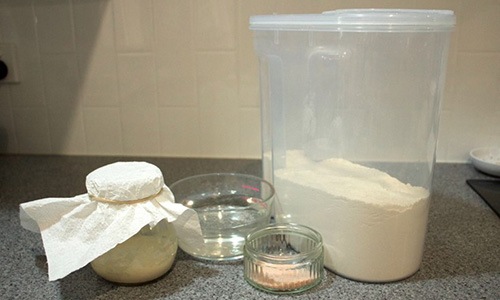
Ingredients:
- 50g or 1⁄4 cup of active sourdough starter
*You can keep reproducing sourdough starter for generations, literally. It’s quite easy to make. All you need to do is mix flour & filtered water into a stiff dough, then leave it for a few days until it starts to turn gray and bubbly. Make sure to feed it with equal parts of flour and water every few days to keep it thriving.
Related: How To Cultivate Your Own Wild Yeast Starter
- 350g or 1 & ⅓ cups + 2 tablespoons of warm/lukewarm filtered water
- 500g or 4 cups + 2 tablespoons of bread flour
*Any type of grain-based flour will work well for making sourdough. But bread flour works best.
- 9g or 1&1/2 tablespoons of sea salt
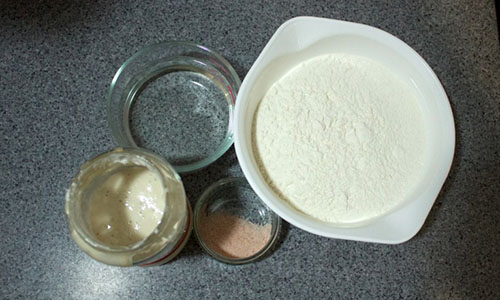 Preparation:
Preparation:
#1. Feed the sourdough starter at least four to eight hours or more before you use it for baking.
#2. Whisk the starter and water together in a large bowl.
#3. Add the flour and salt. Keep mixing until a stiff dough is formed. Finish by mixing it thoroughly with your hand to fully blend the flour in. The dough should feel dense and sticky.
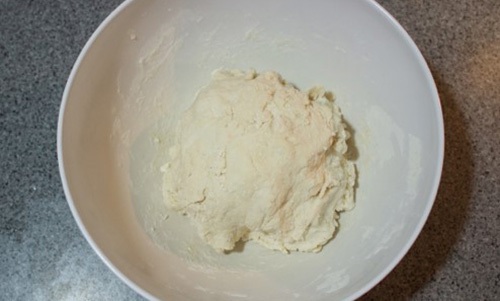 #4. Cover with a damp towel and let it sit for 30 minutes.
#4. Cover with a damp towel and let it sit for 30 minutes.
#5. After it’s rested, work the dough into a smooth shaped ball. You can do this by grabbing the sides of the dough and folding it over and pressing your fingertips into the center of the dough. Repeat this around the dough until it tightens.
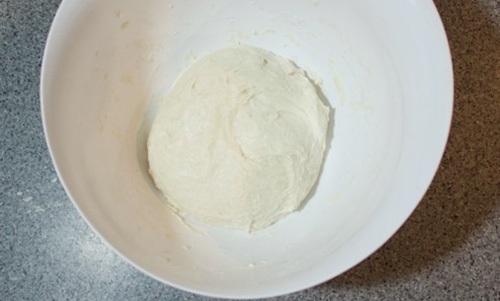 #6. Cover the bowl with a damp towel and let it rise overnight (at least 8-12 hours) at room temperature. The dough should be double its size, and it should no longer look dense.
#6. Cover the bowl with a damp towel and let it rise overnight (at least 8-12 hours) at room temperature. The dough should be double its size, and it should no longer look dense.
#7. Place the dough onto a lightly floured surface and shape it there until it’s round. Flip the dough over and let it sit for around 5-10 minutes.
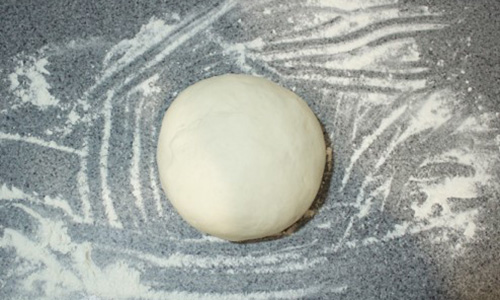 #8. Place a sheet of parchment paper or a towel in a bowl with the seams extending down. Sprinkle the towel or parchment paper freely with flour. You may also use a floured proofing bowl. Put the dough into the bowl and cover. Let it sit for around 30 minutes to an hour.
#8. Place a sheet of parchment paper or a towel in a bowl with the seams extending down. Sprinkle the towel or parchment paper freely with flour. You may also use a floured proofing bowl. Put the dough into the bowl and cover. Let it sit for around 30 minutes to an hour.
#9. Preheat your oven to 450 degrees Fahrenheit. Place a cast-iron pot or any other oven-safe pot in the oven with a lid on to preheat. And take it out once the dough is done resting.
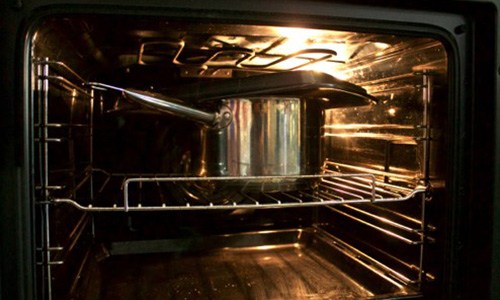 #10. Prepare a piece of parchment paper that has enough length for you to be able to pull the bread out of the pot. (You will gently place the dough onto this paper later with the seams facing up.)
#10. Prepare a piece of parchment paper that has enough length for you to be able to pull the bread out of the pot. (You will gently place the dough onto this paper later with the seams facing up.)
#11. Using any sharp tool, score the bread with one line or with a cross pattern (or however way you want). And place it in the pot and put the lid on.
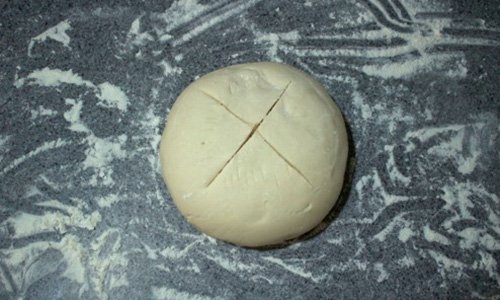 #12. Place it in the oven and bake for 20 minutes. After this, take the lid off and continue to bake the bread uncovered for an additional 25-30 minutes.
#12. Place it in the oven and bake for 20 minutes. After this, take the lid off and continue to bake the bread uncovered for an additional 25-30 minutes.
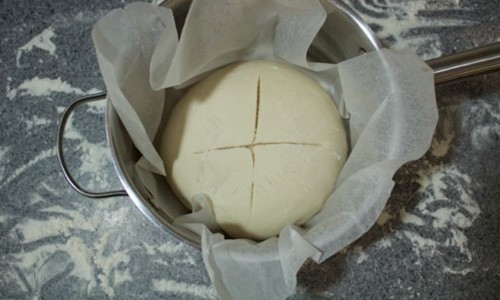 #13. Once the loaf is done, transfer it to a cooling rack. Let it cool for 30 minutes to an hour before you slice it.
#13. Once the loaf is done, transfer it to a cooling rack. Let it cool for 30 minutes to an hour before you slice it.
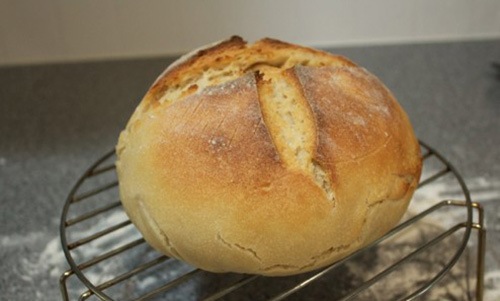 Slice, serve, store, or enjoy!
Slice, serve, store, or enjoy!
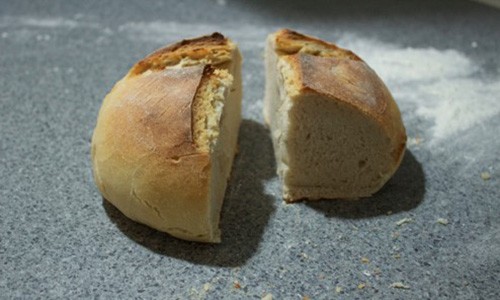 How Long Can Sourdough Bread Last?
How Long Can Sourdough Bread Last?
No-knead sourdough bread generally has a lifespan of between 4-5 days at room temperature. But if you decide to freeze the sourdough bread, it can last for about 3-6 months.
Sourdough bread has natural mold-resistant properties, and it contains less moisture than other types of bread, which is why it usually stays fresher for a longer time. The natural acidity contained within a loaf of sourdough bread also deters bacteria.
Related: How to Make Emergency Survival Bread
Storing The Sourdough Bread Properly
You would want to let your fresh loaf of sourdough bread breathe. The best way to store a fresh loaf is by putting it in a cotton bread bag, a paper bag, plastic wrap, or by wrapping it in a large tea towel. These storage methods let the air circulate and prevent the bread from drying out too quickly. Place the loaf of bread in a fairly cool place for it to maintain ideally normal moisture levels.
For sourdough bread that’s about three days old, it would be ideal to store them in an enclosed container. You can make use of a bread box, a plastic container, or a Ziploc bag. Leaving them out for too long will cause them to dry out and become too stale and hard. But enclosing them will trap the loaf’s moisture, leaving the crust with a soft texture.
You may also use natural beeswax wrap to store your sourdough bread. Beeswax wraps are naturally porous and won’t trap too much moisture in the loaf.
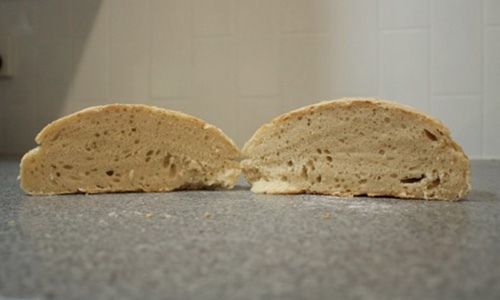 What To Avoid
What To Avoid
Do not store the sourdough bread in the fridge. A fridge is a very dry environment and will make the bread harden too quickly. Storing the sourdough loaves in a plastic bag is also not a good idea since the plastic bag may cause the bread to moisten. If the bread becomes too moist and warm, it will most likely develop bacteria.
Related: How To Prevent Your Food from Spoiling?
Freezing Sourdough Bread
If you want to store slices or loaves of sourdough bread for a prolonged period, then you will have to wrap them in cling wrap, Ziploc bags, or Mylar bags and place them in the freezer. Make sure to squeeze out any excess air in each loaf of bread’s wrapping before you seal it. Also, remember to protect your bread from freezer burn by wrapping it thoroughly. And you must let the bread cool down first before you freeze it.
As mentioned earlier, if it is stored properly in the freezer, sourdough bread will last anywhere from 3 to 6 months. Keep in mind, however, that its flavor and freshness will not anymore be the same the longer you store it. But, if you follow these steps well, then the frozen loaf may still taste almost as good as a fresh loaf when you consume it.
Slicing the loaf of bread before you freeze it may be more convenient if you only want to defrost one or two slices at a time for consumption.
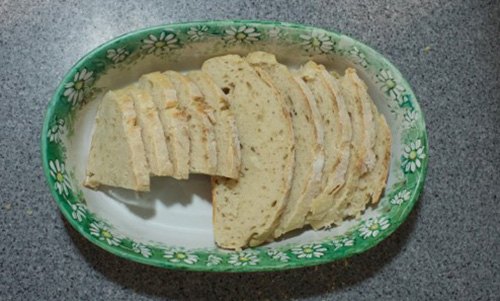 Refreshing The Bread After Freezing
Refreshing The Bread After Freezing
When thawing the bread, leave it at room temperature in the bag for several hours or overnight (depending on how big the loaf is). After it has fully defrosted, it should be ready to eat. You may also re-bake or toast the sourdough bread if you want it to be crispier and have the same texture as a fresh loaf of bread.
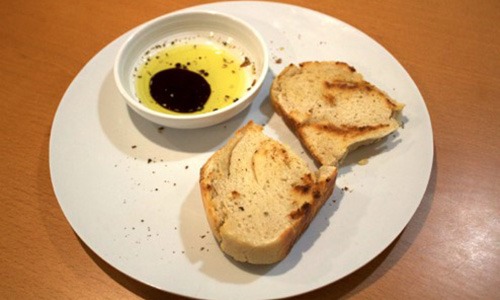 A slice of sourdough bread may only take around ten minutes to defrost at room temperature before it’s ready to eat. Because a slice defrosts quicker, the bread will retain its fresh taste and texture.
A slice of sourdough bread may only take around ten minutes to defrost at room temperature before it’s ready to eat. Because a slice defrosts quicker, the bread will retain its fresh taste and texture.
Sourdough bread can be served however way you like. This delicious bread takes minimal effort to make and is composed of simple ingredients. Be prepared for any shortages by honing your baking skills by practicing with this no-knead sourdough bread.
You may also like:
 Canning Pasta Sauce for Long Term Preservation
Canning Pasta Sauce for Long Term Preservation
How to Make Bark Bread from a Tree that Grows on Almost Every Street in America (Video)
What Is The Best Way To Store Water For SHTF?
WARNING: Top 1% Farmer Voices His Concerns About The Coming Food Crisis

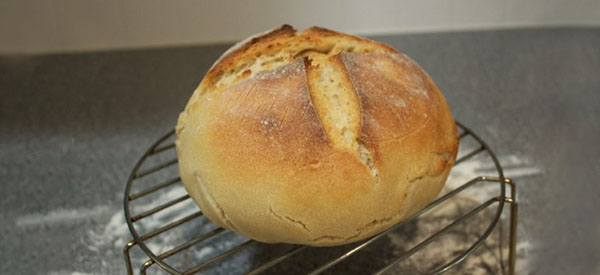













Great one. And simple… I will try it for sure!
Can gluten free flour be also used? My kids have gluten allergies..
From p. 56 of ‘Centennial Kitchen’ ‘All-Time Favourite Bread Recipes’ 10/19/20 quote:
‘The acids that build up in a fermenting sourdough loaf make it taste great, but their work doesn’t stop there. These organic acids also make minerals and vitamins in flour more available than in other breads, and they reduce the rate at which glucose is released into the bloodstream. Sourdoughs are lower on the glycemic index than other breads. The acids also make gluten more digestible.
‘Recent research suggests that the transition away from long-fermented bread may actually be responsible for the increase in gluten intolerance people have experienced in the past few decades.’
Check out Aviva Romm, physician and women’s health expert who was mentioned in this article.
Kristan: Now you’re cooking with gas! Sourdough used to be the norm before we got lazy, or every member of the family had to have a job to survive. Asian style noodles are sourdough and once fermented the dough will last months on the shelf if kept sealed. I like koji starter or beer yeast, but natural yeast is good and give different flavors. Different sources of flour will change the flavor but not usually the texture.
If gluten intolerant: Mashed potatoes are excellent for sourdough and traditional. But, some bean flour (most beans we developed in the Americas were for flour) added to make dough is good. yogurt in the started makes as good a starter as adding sugar. guar gum and xanthan added make a lighter loaf that won’t crumble easily. niio
Red, I need some clarification. You use wheat flour for the actual starter. When do you use the gluten free flours.I really would appreciate your recipe, if you are willing to share.
Lisa: No gluten! Yeast feeds on starch and sugar, so anything statchy works. A lot of people use a potato, mashed and liquified.
I like rice flour but boiled rice can be used. Just boil till it’s tender, put rice and some liquid in the food processor, and make a sort of batter. It’ll settle, so stir it when feeding it. I have sourdough in the pantry in soda jugs that’s a year old and still starts bubbling when put to work.
Liquid off the top is a grain vinegar, and those are expensive. Look at the cost of a small bottle of rice wine vinegar. niio
Thank you for this great article. Like many people, I did the sourdough thing this summer. Reached the point where I feel I could remember how to make an edible loaf and understood the process. Edible is the operative word here. While I never expected it to taste like what you buy at the San Francisco airport, it was never better than okay. Fresh bread, especially sourdough, just out of the oven should taste a heck of a lot better than okay. Your very detailed instructions make me want to try again. Really appreciate the help.
Love experimenting. May do both non-GMO wheat and the rice starters. Will let you know.
Lisa: Remember the yogurt. It boosts the action. And, if you can’t keep using enough to keep it working, freeze some in case the batch wears out. It can be dried, as well. niio
Thank you Red! That’s good to know.
Isn’t 350g a lot of water? The loaf I make every other day uses 500g flour, 8g salt, and 285g water. The recipe calls for 9g salt, but that’s too salty for me! Also I’ve made a few variations that make for a might tasty and consistent loaf.
As long as the starter is fed regularly and not stored in the fridge, try this:
Feed starter and with the spoon you used to stir the starter, mix 400g flour with 285g water (I use 100g whole wheat and 300g bread flour). Let starter set until it’s bubbly and ready.
Then add 150g of starter, the remaining 100g flour, and the salt to the flour water mix. Let it set for about half an hour, then give another good mix to make sure everything is well blended, then cover and stick in the fridge for 24 to 48 hours. This doesn’t raise the dough, but it develops lots of tang.
After some time in the fridge, let dough set out for about 8ish hours until it is well raised.
Dump it out of the bowl onto parchment paper with flour or corn meal and or sesame seeds. Form the dough by hand, closing up the raw dough that was in the bottom of the bowl and flipping it over so the part that was up in the bowl is the part that is up on the parchment. Cover with a towel and let sit for 30 minutes while warming your cooking pot in the oven (I use an enameled cast-iron pot with a lid) at 475F.
Then slash loaf to your liking, lift it into the pot by the parchment, put on the lid and bake at 425F for 20 minutes. Remove lid and bake another 20ish minute on 425F with convection.
When done, remove from pot and parchment and cool on a wire rack. Try not to eat it while it’s still hot. Good luck with that part. I never make it past about 10 minutes.
I use 240g starter, 350g water, 9g salt and 625g of bread flour and a similar technique as above and it comes out great!
Hi Karlee, does you shape that into one huge loaf, or do you make two?
With no oven but a good cast iron pot i make more sourdough pancakes than loaves of bread. I just ta I e starter, add just enough flour to make a pourable batter. Sometimes the starter is just right as is. Just make sure to leave some for the next batch and feed as needed. Hubby likes a bit of cinnamon and vanilla stirred into the batter and make pancakes as usual. I do sometimes make bread. Heat the cast-iron pot or real deep frying pan till quite hot. Turn the burner to a medium heat and cook pancakes till done. You may find them a but more dense than bix mixes but they are great with syrup, jelly, or fruit and creamy peanut butter.
Hi clergylady
You just add flour? Recipes seen to always call for baking soda, but I don’t know why. And if you say it works fine without, I believe you.
Mostly I just read, but since I’m participating this time, I’d like to say that you are one of several people on here that impress and inspire me. Thank you.
This makes me want to start another batch. I didnt care for mine during and after covid. Now I’ll have to start over. My last batch lasted most of the last 10 years.
Clergy lady, your pancakes sound awesome! It’s great that you have recuperated to the point where you want to do This and will be able to enjoy the results.
Pancakes with the discarded starter. Love the idea. 2 eggs then flour to make a batter. Have my own chickens, so super fresh eggs are already here.
The title says NO KNEAD but you kneaded the bread and you shaped it so the title is wrong
Gen no. Kneading and mixing are two different things.
Is this much salt neccessary? Tastes too salty. Also is there a way to soften the crust?
Mary: try reducing the salt to 8g. The recipe still works fine with that amount.
Mary: Or leave salt out. we don’t eat much salt. niio
When you say to feed the starter, with 1/4 cup of starter how much flour and water do you add to feed?
Lahines100: Equal amounts. Water=Starter=Flour